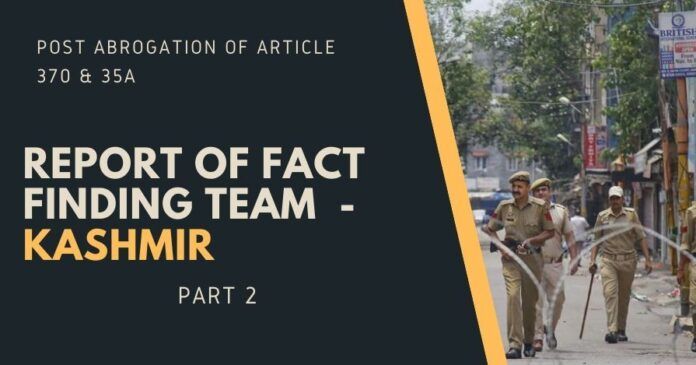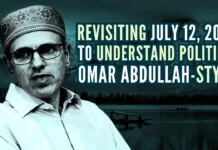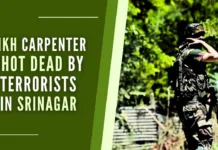
The Previous part of this article comprised of a report from Suburban and Rural Kashmir and interactions with residents of Dal Lake and Civil Society in Srinagar.
Report on meeting with the Shia Community
One significant minority in Kashmir is the Shia community of the Valley. It was very difficult to contact or interview leaders and members of this community in Kashmir. One reason is that they are extremely reluctant to be quoted or named due to fears of persecution by Kashmiri Sunnis.
Kashmiri Shias at present form an important part of the Hurriyat leadership in Kashmir. However, some respondents from the community also spoke of neglect by the Government. At one time, they were the main hub of Kashmiri papier-machie and silk handicrafts, discrimination and Government apathy have killed the livelihood of these artisans.
They seek special schemes and reservations in jobs for their community which they feel has been neglected so far. The average Shia resents the fact that the political scene has been dominated by only the Aghas and the Ansaris, they also complained that many Shia strongholds were deliberately diluted by adding them to totally unrelated Constituencies.
Bazaars and shops were closed by people due to threats from terrorists. There was no curfew or restriction from the side of the government for normal functioning
Main Issues Identified:
1. A Special Advisory board for Shias.
2. Reservations in Employment.
3. A Shia Waqf Board to be set up in Kashmir
Report on Meeting with Sikh Community
We met many members of the Sikh community during our vis Kashmir visit. We went to the Gurudwara Chhati Pathshahi in downtown Rainawari. We visited the area around it and saw the construction of a Dharamshala going on in full swing. Respondents told us that:
1. The Sikhs of Kashmir support the setting aside of Article 370 and Art.35 A. This was expressed by the members of the community.
2. They feel that they are now safe and their properties are secure.
3. The Sikhs of Kashmir feel that it is a misconception that they did not suffer during terrorism. Many of them had to move from their villages to safer areas due to threats.
4. Currently, the community suffers from discrimination at all levels.
5. Economically, their well-educated children are not given jobs. Some of them are contractors and businessmen. Their children do not get A- class contractor status. Their applications are never forwarded or resolved. They are only offered jobs in the Army.
6. Due to this most of the Sikh youth have migrated to other parts of India. The ones left behind are facing the Empty Nest Syndrome. They fear that if nothing is done to create buffers for the Sikh community many elders will also migrate outside the State. The community calls this slow migration which will turn into a mass migration.
7. Sikh community leaders also told us that the community often faced the issue of grooming and conversion of Sikh girls. Almost 70 such cases have been documented by the community.
8. In such cases, the police would refuse to file FIRs and delay the investigation. This gave the miscreants time for conversion of the girl and performing the Islamic Nikah ceremony.
9. Some of the Sikhs we met also mentioned how historically their community faced a pogrom in 1947 when many Sikhs were killed in communal riots and the Kabali Raids in the State.
10. Regarding the present conditions in Kashmir after the policy changes of August 5, 2019, the Sikh community members we met made the following observations:
a. The withdrawal of mobile connectivity and internet in the initial phases was a good step to avoid bloodshed and incidents of violence.
b. Attendance in schools was less because of the fear of stone-pelting on school buses. Also due to lack of mobile connectivity parents were uncertain and apprehensive to send children outside the house.
c. Bazaars and shops were closed by people due to threats from terrorists. There was no curfew or restriction from the side of the government for normal functioning.
d. Public transport was not plying because of the fear of stone-pelting.
e. The Sikhs are facing no problems in coming to the Gurudwara and observing their daily religious practices.
f. There was some stone-pelting in Rainawari after August 5, 2019, however, the forces managed to control the situation.
The Sikh community gave the following recommendations for their community:
1. The GOI must link directly with Sikhs from Kashmir. (So far Sikhs from Jammu have a greater connect with the GOI).
2. All the benefits of Minorities must be extended to the Sikhs. They asked for a Sikh Advisory Board.
3. The Sikhs must be given representation. There must be reserved seats for them in the Assembly.
4. A major program for providing Jobs and Employment to the Sikh community Youth commensurate with their qualifications.
5. A representative of the Sikh community of Kashmir must be made a part of the Governor’s Advisory Panel.
6. For every 5000 people, there should be a police station manned by a composite force of all communities.
7. The History of Sikhs in Kashmir must be given due recognition. VIP visits must include the Chhati Pathshashi, which is the Gurudwara built when the sixth Guru came to the Valley.
8. There should be a holiday in the State on the Shaheedi Diwas of Guru Tegh Bahadur. Report on the Meeting with Sarpanches
The Fact-finding team met Sarpanches from different villages in Kashmir. We met
1. Sardar Bikram Singh, the Sarpanch of Bunahama, Budgam.
2. Aftab Ahmed Beg, Kralvyeth, Kunzer, Baramulla
3. Gulham Moiuddin Sofi, Baramulla
4. Babita Bhatt, Ladoo, Pampore
5. Shahzareena, Mandakpal, Pampore
6. Maimuna Begam, Kreeri
7. Nasir Ahmed Khandey, Meej, Pampore
Main Issues identified by them were:
One of them said that there was no support to nationalists and minorities before 5th August 2019. He felt that the police and Administration should be made more minority-friendly. There is a lack of security in crucial areas. Almost 80% of people are happy with the setting aside of the two Articles but are scared to express it. He supported the resumption of mobile connectivity.
He also said that people do not know the meaning and implications of Article 370. The common man does not understand that financial initiative and freedom is very important.
After the setting aside of Article 370 and 35A people have huge expectations. There is a gap which is waiting to be filled. People, especially the youth are looking for jobs and development. There is a huge gap in public work in the villages, this has to be taken care of.
In Kashmir, there was huge corruption. People are fed up of mainstream political parties. They have seen such colossal wrongdoing and scams in every sphere that they feel no sympathy for the mainstream political parties and jailed leaders. Rather he feels that the GOI should act decisively and expose these leaders.
He specifically mentioned the nexus of bureaucrats and ministers who have not allowed the Panchayati Raj system to work in Jammu and Kashmir.
One of the female Sarpanches said that post-August 5, 2019, almost all normal functioning was disrupted in her village but now people venture out of their houses for daily needs and activities like prayers and purchase of essential items. The armed forces are not stopping or restricting anyone’s movement in her village, women in the village are safe.
We met a young woman sarpanch belonging to the Gujjar Community, her villagers also ethnically diverse. There are a number of developmental issues in her village. She shared that Centrally Sponsored Schemes are not reaching the people of that village. People urgently need toilets, houses, roads. People in the village are disturbed after August 5 2019. However, she clearly indicated that a small group of people are dominating the narrative about Article 370 and 35A.
This is the genocide that Kashmir, as well as the Government of India and the International community, needs to talk about and recognize.
Main Issues Identified
1. There is an immediate need to reaffirm the importance of decentralization in Jammu and Kashmir. Mainstream political parties (to which some of the people we spoke belonged) have systematically kept power and development away from the common people of Kashmir.
2. The Sarpanches have been at the receiving end of political bullying but have stood up to it at severe personal risk and sacrifice. This is a constituency that needs immediate reassuring and constant support immediately.
3. There are women Sarpanches in Kashmir who are active, informed and successful. They are another group that needs support and outreach.
Report on Meeting with Kashmiri Hindus
The FFT met Kashmiri Hindus at a Transit Camp set up for Migrant Employees in Sheikhpora, Budgam. Residents of the Camp recounted their personal experiences of a forced exodus from the Valley.
It houses around 600 Kashmiri Hindu Employees of the J&K Government, construction began in 2008 but the inhabitants say that it wasn’t till 2010 that they were allowed to move there. Our vehicle was allowed to enter only after some stringent checks, testifying to the fact that the Kashmiri Hindus still require protection in their own region.
At present, she says that they are sometimes taunted for being “Indian Agents‟. However, she says her colleagues are generally fine with her and she doesn’t face hostility at her Workplace. She was unsure about the changes in their lives after Article 370 was set aside. However, she did say that if good educational institutions come up in the Valley now, their children will remain in Kashmir.
They recalled that the Kashmiri Hindu exodus in 1990 took place within a span of three months, between the assassination of Sh. Tika Lal Taploo and Sh. Prem Nath Bhat. These three months was a culmination of years of targeted persecution due to their religious and ethnic identity. This is the genocide that Kashmir, as well as the Government of India and the International community, needs to talk about and recognize.
There is a sense of pain that the majority community in the valley still does not acknowledge what they faced. The Kashmiri Hindus also observed that most delegations/teams that visit Kashmir tend to bypass these Camps.
They want a single settlement, minority status, reservation in jobs, political empowerment. After living in cramped accommodation for years, they yearn to own a plot of land where they can build and own their houses once more.
Main issues identified:
1. The numerical strength of Kashmiri Hindus is not an important factor. They represent the civilizational integrity of the region with the rest of the country. They can be a small but important part of future policies in Kashmir.
2. The settlement of Kashmiri Hindus in a twin city model (for instance New Srinagar) would facilitate their return, stay in Kashmir.
3. Kashmiri Hindus who are in Kashmir are still viewed as “agents‟ due to their religious identity. This is a continuation from the past 70 years.
4. Most respondents amongst the locals still evade the issue of the 1990 exodus and petulantly insist on parroting the baseless “Jagmohan Theory‟.
to be continued…
- Supreme Court rejects plea to tally all VVPAT slips with EVM votes; says ‘no going back to paper ballot’ - April 26, 2024
- US report citing human rights violations is deeply biased: India - April 25, 2024
- Kotak Mahindra Bank shares tank 13%. Market Cap erodes by Rs.37,721 cr post-RBI action - April 25, 2024










